Case Based Questions Test: Units & Measurement - NEET MCQ
10 Questions MCQ Test - Case Based Questions Test: Units & Measurement
Measurement of the time period of a simple pendulum and the associated errors:
5 students were asked to measure the time period of a pendulum. They obtained the following result:
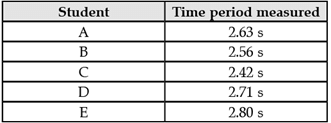
The teacher explained 4 different types of errors involved in their observations:
Absolute error: It is the difference of the arithmetic value of all the measured values and each of the measured values.
Mean absolute error: It is the arithmetic mean of the value of absolute errors.
Fractional error: It is the ratio of the mean absolute error to the arithmetic mean of the measured values.
Percentage error: It is the fractional error multiplied by 100.
What is the mean time period of oscillation of the pendulum?

Measurement of the time period of a simple pendulum and the associated errors:
5 students were asked to measure the time period of a pendulum. They obtained the following result:
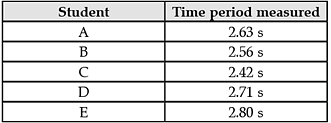
The teacher explained 4 different types of errors involved in their observations:
Absolute error: It is the difference of the arithmetic value of all the measured values and each of the measured values.
Mean absolute error: It is the arithmetic mean of the value of absolute errors.
Fractional error: It is the ratio of the mean absolute error to the arithmetic mean of the measured values.
Percentage error: It is the fractional error multiplied by 100.
What is the value of the mean period of oscillation of the pendulum ?

| 1 Crore+ students have signed up on EduRev. Have you? Download the App |
Measurement of the time period of a simple pendulum and the associated errors:
5 students were asked to measure the time period of a pendulum. They obtained the following result:
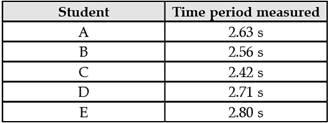
The teacher explained 4 different types of errors involved in their observations:
Absolute error: It is the difference of the arithmetic value of all the measured values and each of the measured values.
Mean absolute error: It is the arithmetic mean of the value of absolute errors.
Fractional error: It is the ratio of the mean absolute error to the arithmetic mean of the measured values.
Percentage error: It is the fractional error multiplied by 100.
The time period of the pendulum may lie between

Vernier calipers:
Vernier calipers are used to measure the thickness of thin plates, diameters of small cylinders etc. It has two scales–one main scale and a Vernier scale, which slides along the main scale. The main scale and Vernier scale are divided into small divisions though of different magnitudes. The difference in the magnitude of one main scale division (M.S.D.) and one vernier scale division (V.S.D.) is called the least count of the instrument, as it is the smallest distance that can be measured using the instrument. It is also known as vernier constant. Least count may also be defined as:
![]()
When the jaws of vernier calipers touch each other, the zero of the Vernier should coincide with the zero of the main scale. If it is not so, then the instrument is said to have zero error. Zero error may be positive or negative, depending upon whether the zero of the vernier scale lies to the right or to the left of the zero of the main scale.
The least count of the instrument when 1MSD = 0.1 cm and number of vernier scale division = 10 is
Vernier calipers:
Vernier calipers are used to measure the thickness of thin plates, diameters of small cylinders etc. It has two scales–one main scale and a Vernier scale, which slides along the main scale. The main scale and Vernier scale are divided into small divisions though of different magnitudes. The difference in the magnitude of one main scale division (M.S.D.) and one vernier scale division (V.S.D.) is called the least count of the instrument, as it is the smallest distance that can be measured using the instrument. It is also known as vernier constant. Least count may also be defined as:
![]()
When the jaws of vernier calipers touch each other, the zero of the Vernier should coincide with the zero of the main scale. If it is not so, then the instrument is said to have zero error. Zero error may be positive or negative, depending upon whether the zero of the vernier scale lies to the right or to the left of the zero of the main scale.
Vernier constant is defined as
Vernier calipers:
Vernier calipers are used to measure the thickness of thin plates, diameters of small cylinders etc. It has two scales–one main scale and a Vernier scale, which slides along the main scale. The main scale and Vernier scale are divided into small divisions though of different magnitudes. The difference in the magnitude of one main scale division (M.S.D.) and one vernier scale division (V.S.D.) is called the least count of the instrument, as it is the smallest distance that can be measured using the instrument. It is also known as vernier constant. Least count may also be defined as:
![]()
When the jaws of vernier calipers touch each other, the zero of the Vernier should coincide with the zero of the main scale. If it is not so, then the instrument is said to have zero error. Zero error may be positive or negative, depending upon whether the zero of the vernier scale lies to the right or to the left of the zero of the main scale.
Which of the following figures has no zero error?

Vernier calipers:
Vernier calipers are used to measure the thickness of thin plates, diameters of small cylinders etc. It has two scales–one main scale and a Vernier scale, which slides along the main scale. The main scale and Vernier scale are divided into small divisions though of different magnitudes. The difference in the magnitude of one main scale division (M.S.D.) and one vernier scale division (V.S.D.) is called the least count of the instrument, as it is the smallest distance that can be measured using the instrument. It is also known as vernier constant. Least count may also be defined as:
![]()
When the jaws of vernier calipers touch each other, the zero of the Vernier should coincide with the zero of the main scale. If it is not so, then the instrument is said to have zero error. Zero error may be positive or negative, depending upon whether the zero of the vernier scale lies to the right or to the left of the zero of the main scale.
Which figure shows positive zero error and which one shows positive zero error?
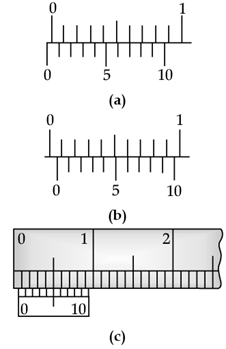
Vernier calipers:
Vernier calipers are used to measure the thickness of thin plates, diameters of small cylinders etc. It has two scales–one main scale and a Vernier scale, which slides along the main scale. The main scale and Vernier scale are divided into small divisions though of different magnitudes. The difference in the magnitude of one main scale division (M.S.D.) and one vernier scale division (V.S.D.) is called the least count of the instrument, as it is the smallest distance that can be measured using the instrument. It is also known as vernier constant. Least count may also be defined as:
![]()
When the jaws of vernier calipers touch each other, the zero of the Vernier should coincide with the zero of the main scale. If it is not so, then the instrument is said to have zero error. Zero error may be positive or negative, depending upon whether the zero of the vernier scale lies to the right or to the left of the zero of the main scale.
A vernier callipers has vernier divisions = 10 and least count = 0.2 mm. What is the smallest distance can measured by this instrument?
Measurement of the time period of a simple pendulum and the associated errors:
5 students were asked to measure the time period of a pendulum. They obtained the following result:

The teacher explained 4 different types of errors involved in their observations:
Absolute error: It is the difference of the arithmetic value of all the measured values and each of the measured values.
Mean absolute error: It is the arithmetic mean of the value of absolute errors.
Fractional error: It is the ratio of the mean absolute error to the arithmetic mean of the measured values.
Percentage error: It is the fractional error multiplied by 100.
What are the absolute errors of student A and B?
Measurement of the time period of a simple pendulum and the associated errors:
5 students were asked to measure the time period of a pendulum. They obtained the following result:
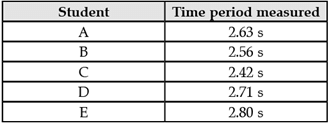
The teacher explained 4 different types of errors involved in their observations:
Absolute error: It is the difference of the arithmetic value of all the measured values and each of the measured values.
Mean absolute error: It is the arithmetic mean of the value of absolute errors.
Fractional error: It is the ratio of the mean absolute error to the arithmetic mean of the measured values.
Percentage error: It is the fractional error multiplied by 100.
What is the value of the fractional error?




















